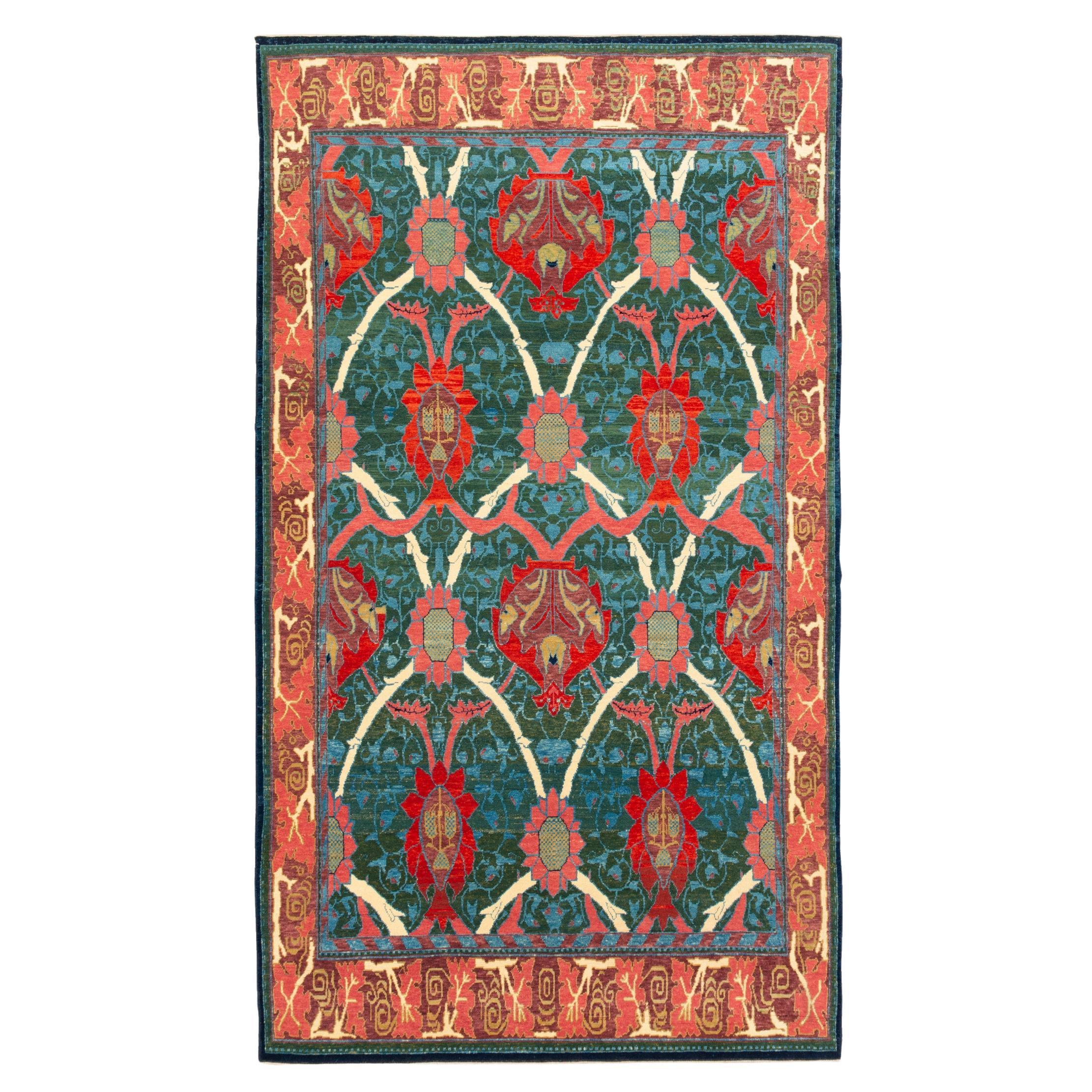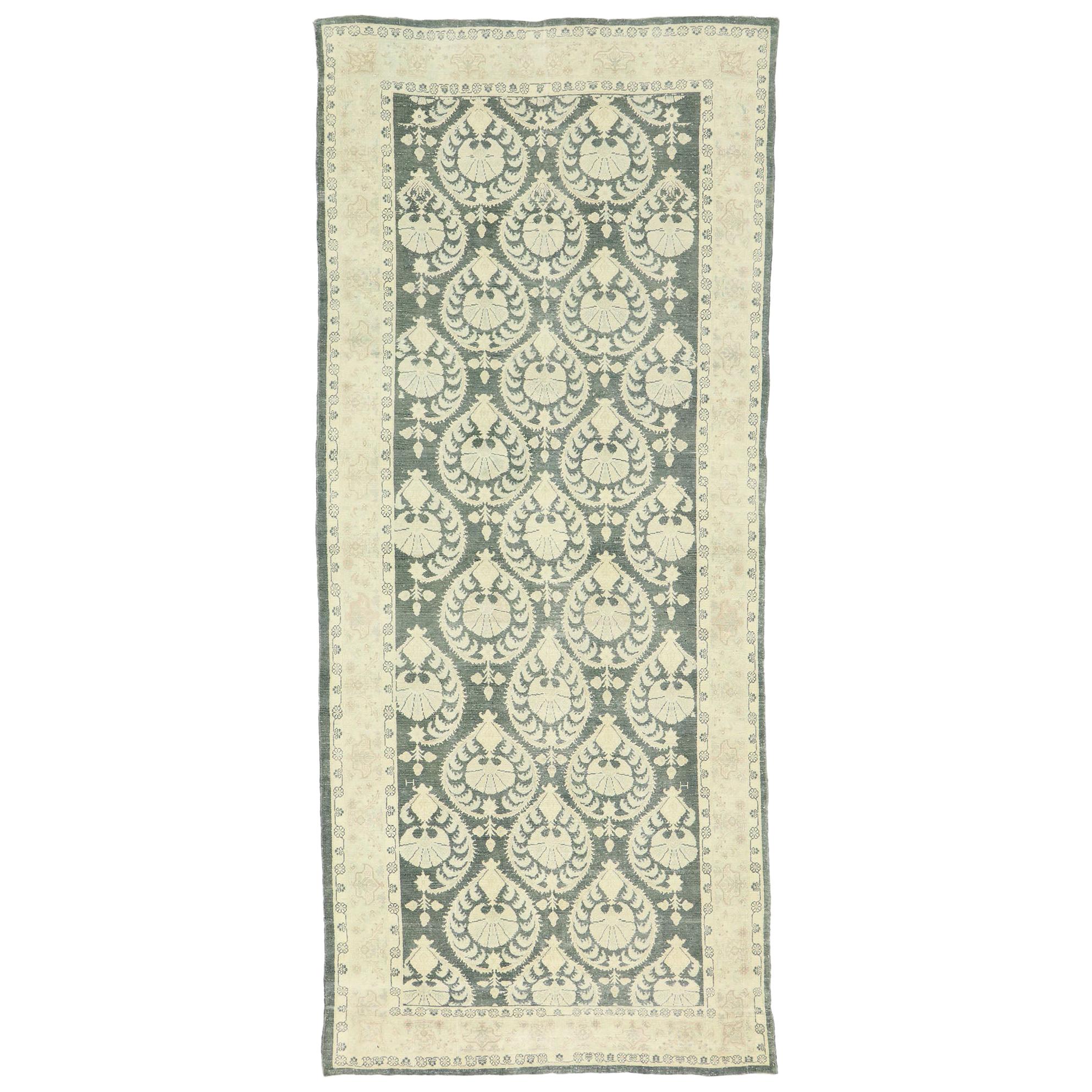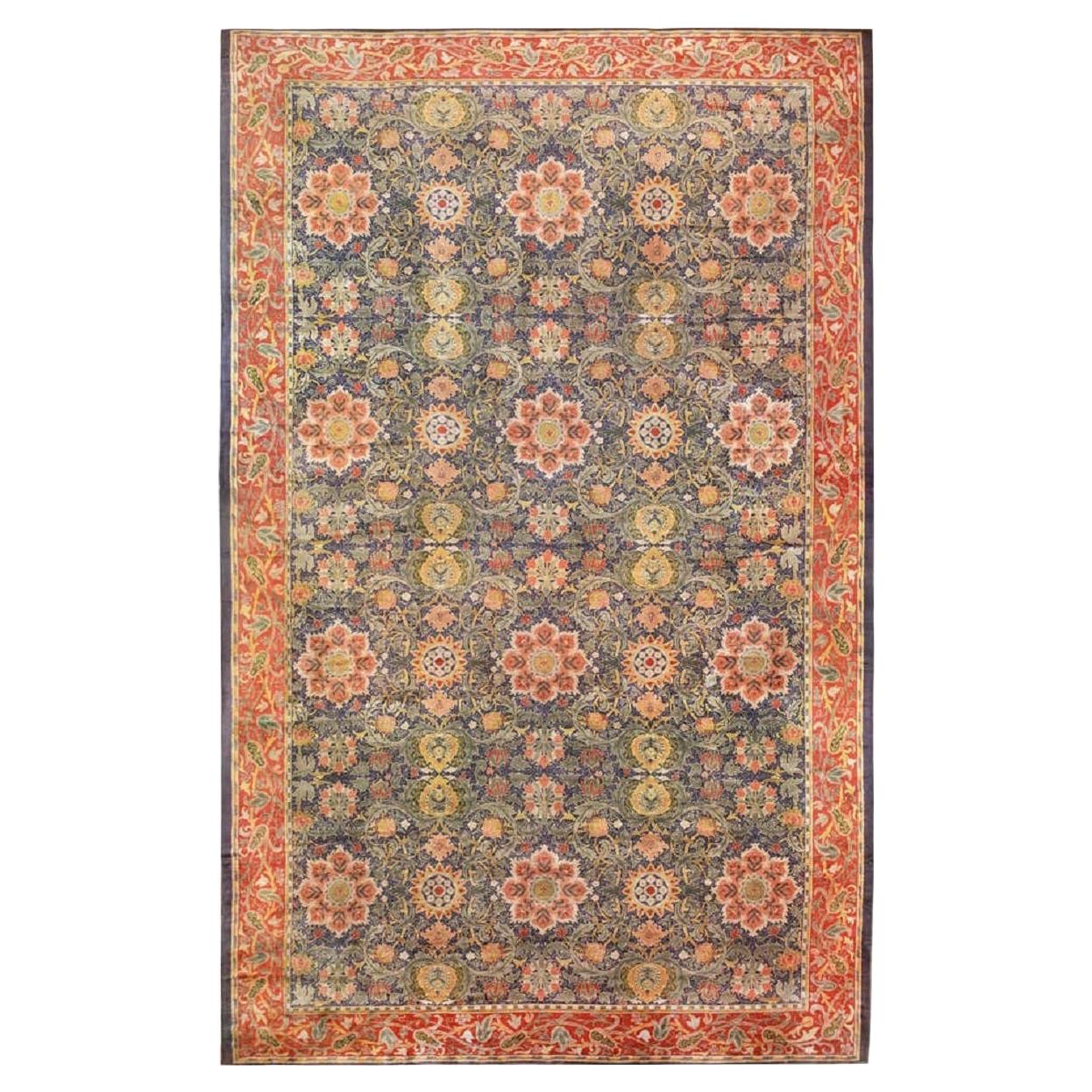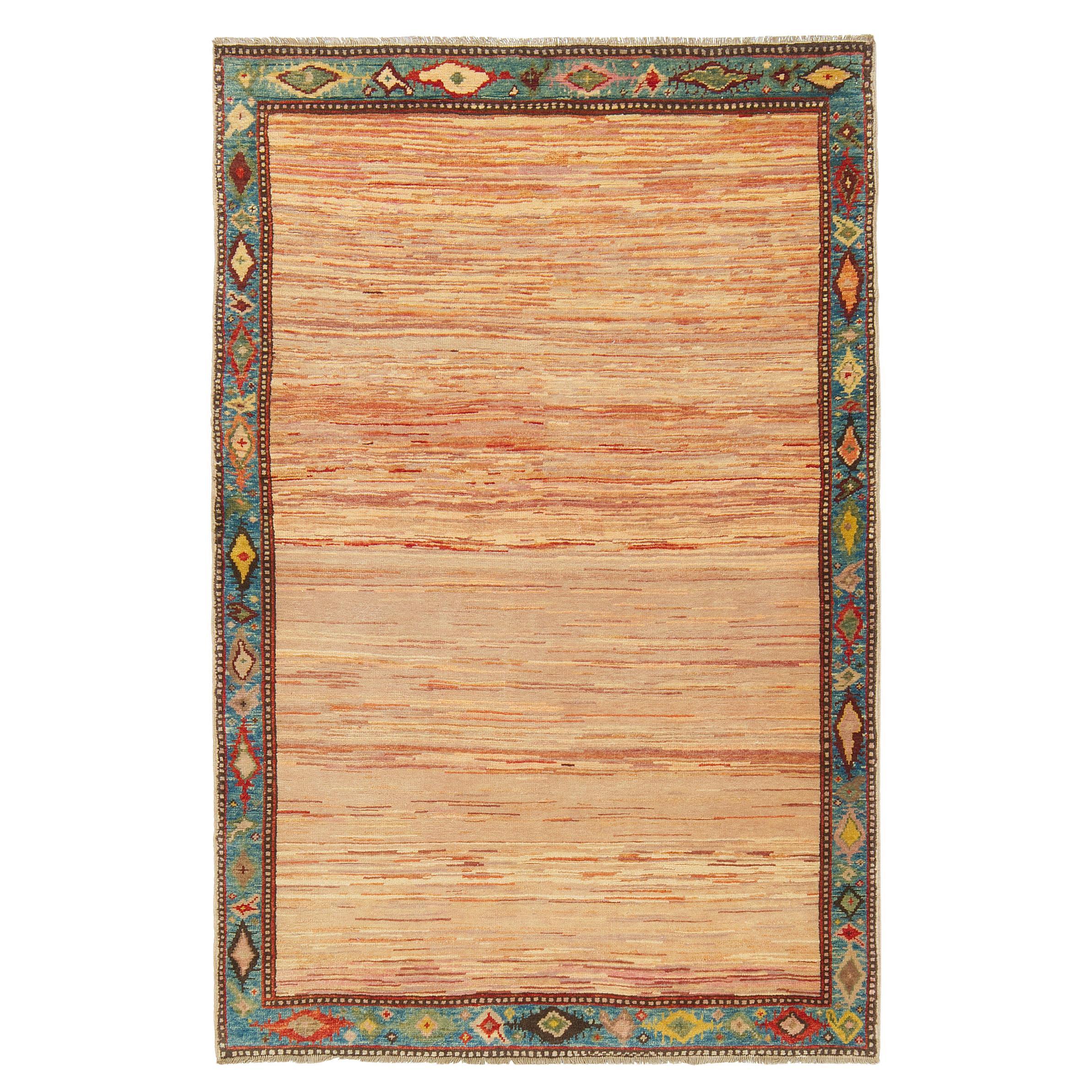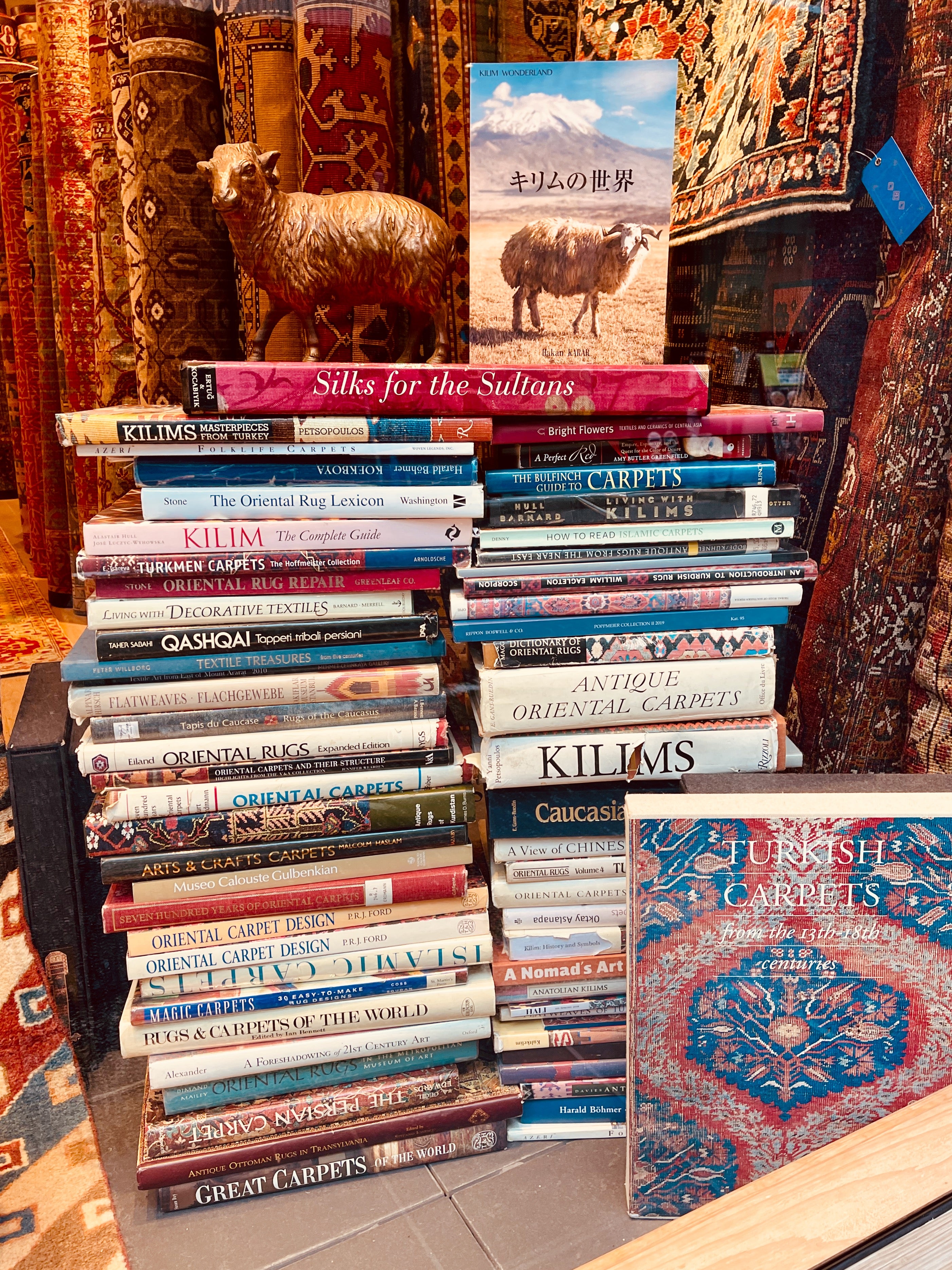Items Similar to Ararat Rugs the Fintona William Morris Carpet, Arts and Crafts, Natural Dyed Rug
Want more images or videos?
Request additional images or videos from the seller
Ararat Rugs the Fintona William Morris Carpet, Arts and Crafts, Natural Dyed Rug
About the Item
The source of the carpet comes from the book Arts & Crafts Carpets, by Malcolm Haslam, and David Black, 1991, fig.55. This Donegal carpet was possibly designed by the Silver Studio for Liberty’s c.1902, United Kingdom. In 1887 English artist and bookbinder T.J. Cobden Sanderson, suggested that a new group be named the “Arts and Crafts Exhibition Society” As a result, he was the first to use the term “Art and Crafts” and also is credited with naming this new emerging movement. The Arts & Crafts movement was inspired by the degradation of product standards that resulted from the factory production age. The rise of machinery in manufacturing caused a noticeable decline in uniqueness and crafts. These anti-industrial reformers promoted economic advancement and social change. They wanted to eliminate poor quality and “artificial” items from 19th-century British society. They saw a plethora of uninteresting items on display at the Great Exhibition of 1851 and became inspired to launch a campaign for originality and uniqueness.
William Morris was an English designer, as well as an uplifting social activist and writer. Morris is credited with sparking the rebirth of textile arts and traditional means of production. In 1861, Morris and a small group of designers opened an incredibly fashionable design company that grew to be largely successful. Morris left behind works in many different mediums such as textiles, books, furniture, stained glass, and area rugs. But in the end, he is most remembered for the magnificent wallpapers that he designed. He got much of his inspiration from the natural world. Through his interior decor pieces, Morris set out to convert rooms or spaces into meadows with beautiful trees meandering, vines, and plants. This concept of taking something industrial and man-made, and converting it into something natural is what William Morris meant when he once said: “-any decoration is futile… when it does not remind you of something beyond itself.”
Morris was a huge commercial success and his works are some of the most sought-after pieces in the world of design and decor. He is also credited with almost single-handedly reviving the British textile arts as well as their methods of production. Morris was also severely critical of machine-made goods, exclaiming, “Today almost all wares that are made by civilized man are shabbily and pretentiously ugly.” Houses were filled “with tons and tons of unutterable rubbish,” which, he suggested, should be heaped onto a gigantic bonfire! “As a condition of life, production by machinery is altogether evil.” He masterminded one of the most well-known styles of Arts & Crafts, recognizable by its twisting and arching patterns and simple, elegant floral design prints. Although Morris believed that Persian carpets were the greatest ever made, he adopted the coarser Turkish (Ghiordes) knot for his own hand-knotted carpet manufacture. They were woven at a thickness of 25 knots to the square inch at that time. Morris & Co.’s rugs are reminiscent of Persian garden design carpets in that they are smartly styled depictions of English gardens. Donegal also started producing highly desirable Irish rugs in the late 19th century. The Donegal rugs were predominantly created by English architects C.F.A. Voysey and Gavin Morton. The hand-crafted Voysey rugs are typically woven in England, Scotland, and Ireland. Voysey had a knack for using contrasting shapes to decorate flat monochromatic spaces. Dark outlines added a flair of drama to his signature pattern and Celtic rug designs. The first Donegal rugs were hand-knotted over a dense wool foundation. Voysey’s designs inspired many other artists, leading to the appearance of a large volume of lookalike rugs. The design of the carpet is interpreted by our designers, and soft colors are used for this carpet.
Color summary: 9 colors in total, most used 4 colors are;
Pink 155 (Cochineal)
Cameo Pink 436 (Cochineal)
Pale Green 439 (Chamomile – Indigo)
Dark Brown 316 (No Dye – Sheep’s own Color)
Group: Arts & Crafts Movement
Area: Europe
Material of Pile: Natural Dyed Hand-spun Wool
Material Warp / Weft: Wool on Wool
Structure: Symmetrical knot on depressed warp inclining to the right
Knots Density: 39x39
Production Place: South Eastern Anatolia – Diyarbakir
Stock Location: Tokyo
Size (EU): 154 X 140cm
Size (US): 5'0" X 4'7"
Area (EU): 2.2m²
Area (US): 23.2ft².
- Creator:Ararat Rugs (Manufacturer)
- Dimensions:Width: 55.12 in (140 cm)Length: 60.63 in (154 cm)
- Style:Arts and Crafts (In the Style Of)
- Materials and Techniques:
- Place of Origin:
- Period:
- Date of Manufacture:2021
- Production Type:New & Custom(One of a Kind)
- Estimated Production Time:Available Now
- Condition:
- Seller Location:Tokyo, JP
- Reference Number:1stDibs: LU8206233063822
ARARAT RUGS
We know and believe that the geography we come from, our past, and our lifestyle are the most important bond between us to carry the oriental carpet art and culture to the next generations along with our core values in our ongoing growth journey.
We are aware that the way to achieve this goal and carry this priceless art and culture to the future depends on a lot of work with all our people every day while adhering to our core values.
For us, art is meaningful in the sense that it brings together various cultures around the world. It is an honor for us that oriental carpet art and culture have been instrumental in this for centuries and that we are a part of this business.
We are tirelessly keeping an eye on auction house information around the world about carpets. New York's Metropolitan, London's Victoria & Albert Museums, and other famous art museums, as well as small specialized museums that house private collections, and books about oriental carpets to collect information on outstanding carpet designs and patterns from around the world. It's our Self-improving and Self-developing culture.
As Turkish Culture of Hospitality, the Kurdish Culture of Generosity, and as Japanese Culture of Business Punctuality; are the most important values that this multicultural background has taught and bequeathed to us. It is essential and valuable for us that you feel this feeling not only by looking at our oriental carpets but from the moment you contact us.
About the Seller
5.0
Vetted Seller
These experienced sellers undergo a comprehensive evaluation by our team of in-house experts.
Established in 1970
1stDibs seller since 2023
13 sales on 1stDibs
Typical response time: 1 hour
- ShippingRetrieving quote...Ships From: Tokyo, Japan
- Return PolicyA return for this item may be initiated within 7 days of delivery.
More From This SellerView All
- Ararat Rugs Holland Park William Morris Carpet, Arts and Crafts, Natural DyedBy Ararat RugsLocated in Tokyo, JPThe source of carpet comes from the book Arts & Crafts Carpets, by Malcolm Haslam, and David Black, 1991, fig.49. This Hammersmith carpet was designed by William Morris in 1882, in the United Kingdom. In 1887 English artist and bookbinder T.J. Cobden Sanderson, suggested that a new group be named the “Arts and Crafts Exhibition Society” As a result, he was the first to use the term “Art and Crafts” and also is credited with naming this new emerging movement. The Arts & Crafts movement was inspired by the degradation of product standards that resulted from the factory production age. The rise of machinery in manufacturing caused a noticeable decline in uniqueness and crafts. These anti-Industrial reformers promoted economic advancement and social change. They wanted to eliminate poor quality and “artificial” items from 19th century British society. They saw a plethora of uninteresting items on display at the Great Exhibition of 1851 and became inspired to launch a Campaign for originality and uniqueness. William Morris was an English designer, as well as an uplifting social activist and writer. Morris is credited with sparking the rebirth of textile arts and traditional means of production. In 1861, Morris and a small group of designers opened an incredibly fashionable design company that grew to be largely successful. Morris left behind works in many different mediums such as textiles, books, furniture, stained glass, and area rugs. But in the end, he is most remembered for the magnificent wallpapers that he designed. He got much of his inspiration from the natural world. Through his interior decor pieces, Morris set out to convert rooms or spaces into meadows with beautiful trees meandering, vines, and plants. This concept of taking something Industrial and man-made, and converting it into something natural is what William Morris meant when he once said: “-any decoration is futile… when it does not remind you of something beyond itself.” Morris was a huge commercial success and his works are some of the most sought-after pieces in the world of design and decor. He is also credited with almost single-handedly reviving the British textile arts as well as their methods of production. Morris was also severely critical of machine-made goods, exclaiming, “Today almost all wares that are made by civilized man are shabbily and pretentiously ugly.” Houses were filled “with tons and tons of unutterable rubbish,” which, he suggested, should be heaped onto a gigantic bonfire! “As a condition of life, production by machinery is altogether evil.” He masterminded one of the most well-known styles of Arts & Crafts, recognizable by its twisting and arching patterns and simple, elegant floral design prints. Although Morris believed that Persian carpets were the greatest ever made, he adopted the coarser Turkish (Ghiordes) knot for his hand knotted carpet manufacture. They were woven at a thickness of 25 knots to the square inch at that time. Morris & Co.’s rugs are reminiscent of Persian garden design carpets in that they are smartly styled depictions of English gardens. Donegal also started producing highly desirable Irish rugs in the late 19th century. The Donegal rugs were predominantly created by English architects C.F.A. Voysey and Gavin Morton. The handcrafted Voysey rugs are typically woven in England, Scotland, and Ireland. Voysey had a knack for using contrasting shapes to decorate flat monochromatic spaces. Dark outlines added a flair of drama to his signature pattern and Celtic rug...Category
21st Century and Contemporary Turkish Arts and Crafts Western European Rugs
MaterialsWool, Natural Fiber, Organic Material
- Ararat Rugs the Blue Color Rug Modern Carpet Natural DyedBy Ararat RugsLocated in Tokyo, JPThis unique design rug is interpreted by our designers with a mixture of Ararat Rugs’ soft blue tone natural dyed hand-spun yarns. This modern carpet is looking like an impressionist...Category
21st Century and Contemporary Turkish Revival Turkish Rugs
MaterialsWool, Natural Fiber, Organic Material
- Ararat Rugs the Soft Pink Color Rug Modern Carpet Natural DyedBy Ararat RugsLocated in Tokyo, JPThis unique design rug is interpreted by our designers with a mixture of Ararat Rugs’ soft tone natural dyed hand-spun yarns. This modern carpet is looking like the sand in the desert. Color summary: 10 colors in total, most used 4 colors are; The mix of Pink Yarns; Dusty Turquoise 340 (Spurge – Madder Root – Indigo – Walnut Husk) Russian Green 418 (Henna – Indigo) Imperial Red 415 (Madder Root) Group: Let Colors Talk Area: East Turkey Material of Pile: Natural Dyed Hand-spun Wool Material Warp...Category
21st Century and Contemporary Turkish Revival Turkish Rugs
MaterialsWool, Natural Fiber, Organic Material
- Ararat Rugs the Soft Pink Color Rug, Modern Carpet, Natural DyedBy Ararat RugsLocated in Tokyo, JPThis unique design rug is interpreted by our designers with a mixture of Ararat Rugs’ soft tone natural dyed hand-spun yarns. This modern carpet is looking like the sand in the desert. Color summary: 10 colors in total, most used 4 colors are; Mixture of Our Pink Colors Dusty Turquoise 340 (Spurge – Madder Root – Indigo – Walnut Husk) Burlywood 135 (Spurge – Madder Root) Imperial Red 415 (Madder Root) Group: Let Colors Talk Area: East Turkey Material of Pile: Natural Dyed Hand-spun Wool Material Warp...Category
21st Century and Contemporary Turkish Revival Turkish Rugs
MaterialsWool, Natural Fiber, Organic Material
- Ararat Rugs the Soft Pink Color Rug, Modern Carpet, Natural DyedBy Ararat RugsLocated in Tokyo, JPThis unique design rug is interpreted by our designers with a mixture of Ararat Rugs’ soft tone natural dyed hand-spun yarns. Color summary: 10 colors in total, most used 4 colors...Category
21st Century and Contemporary Turkish Revival Turkish Rugs
MaterialsWool, Natural Fiber, Organic Material
- Ararat Rugs the Alaeddin Mosque Clouds Carpet Seljuk Revival Carpet Natural DyedBy Ararat RugsLocated in Tokyo, JPThe source of carpet comes from the book Orient Stars Collection, Anatolian Tribal Rugs 1050-1750, Michael Franses, Hali Publications Ltd, 2021 fig.27. This 13th-century carpet is fr...Category
21st Century and Contemporary Turkish Revival Turkish Rugs
MaterialsWool, Natural Fiber, Organic Material
You May Also Like
- Arts & Crafts Style Distressed Vintage Romanian Rug Inspired by William MorrisBy William Morris (English)Located in Dallas, TX53033, distressed vintage Romanian Rug inspired by William Morris with Arts & Crafts style. Reminisce of 19th century French designs and decorativ...Category
Mid-20th Century Romanian Arts and Crafts Western European Rugs
MaterialsWool
- Antique Arts & Crafts William Morris Design Rug. Size: 19 ft x 30 ftBy William Morris (English)Located in New York, NYMagnificent and rare large oversized antique Arts & Crafts William Morris Design rug, country of origin / rug type: Irish rug, circa date: Late 19th century. Size: 19 ft x 30 ft (5.7...Category
Antique Late 19th Century Irish Arts and Crafts Western European Rugs
MaterialsWool
- Arts & Crafts Donegal CarpetLocated in London, GBAntique Donegal Carpets, woven in the town of Killybegs, County Donegal, from the 1890s onwards, represent some of the most unique and highly sought-after European weavings - originally, a Western interpretation of earlier Turkish Oushak carpets, incorporating a wide array of design elements borrowed from both the Arts and Crafts movement and traditional Celtic art. These pieces are also known for their remarkably high quality, thanks to the centuries-old tradition of wool-working belonging to the people of Donegal - early examples can be found in places as prestigious as Dublin Castle, the University of Notre Dame, and the US Whitehouse. This piece, dating to the early 20th Century, features a wonderfully fresh colour palette, and an elegant composition inspired by Arts and Crafts textiles...Category
Early 20th Century Irish Arts and Crafts Western European Rugs
MaterialsWool
- Arts and Crafts RugLocated in New York, NYArts and Crafts Rug Size: 9'10" × 13'3" (299 × 403 cm)Category
Late 20th Century Northern Irish Arts and Crafts Western European Rugs
MaterialsWool
- Contemporary Handwoven Arts and Crafts CarpetLocated in London, GBA contemporary interpretation of 19th century English Arts & Crafts carpets, particularly those of the renowned English textile designer, C.F. A. Voysey, whose works were largely ins...Category
21st Century and Contemporary Arts and Crafts Western European Rugs
MaterialsWool
- Vintage Spanish Arts And Crafts Design CarpetLocated in Katonah, NY:: Covered field in oversized vase outline scrolling vinery in scalloped contour reminiscent of Rococo stylization. Wrapped by a simplistic germinating plant design motif. Colors and...Category
Vintage 1960s Spanish Arts and Crafts Western European Rugs
MaterialsWool, Cotton
Recently Viewed
View AllMore Ways To Browse
Silver Europe
European Made Silver
The Time Machine
European Other Living Room Sets
Large Designer Rugs
Dark Green Rug
Dark Green Rugs
Pink And Black Rug
Western Glass
Western Glasses
Soft Pink Rug
Natural Color Rug Large
Knotted Large Rug Pink
Warp And Weft Rugs
Warp And Weft Rug
Tree Of Life Rug
Most Beautiful Rooms
The Most Beautiful Rooms
